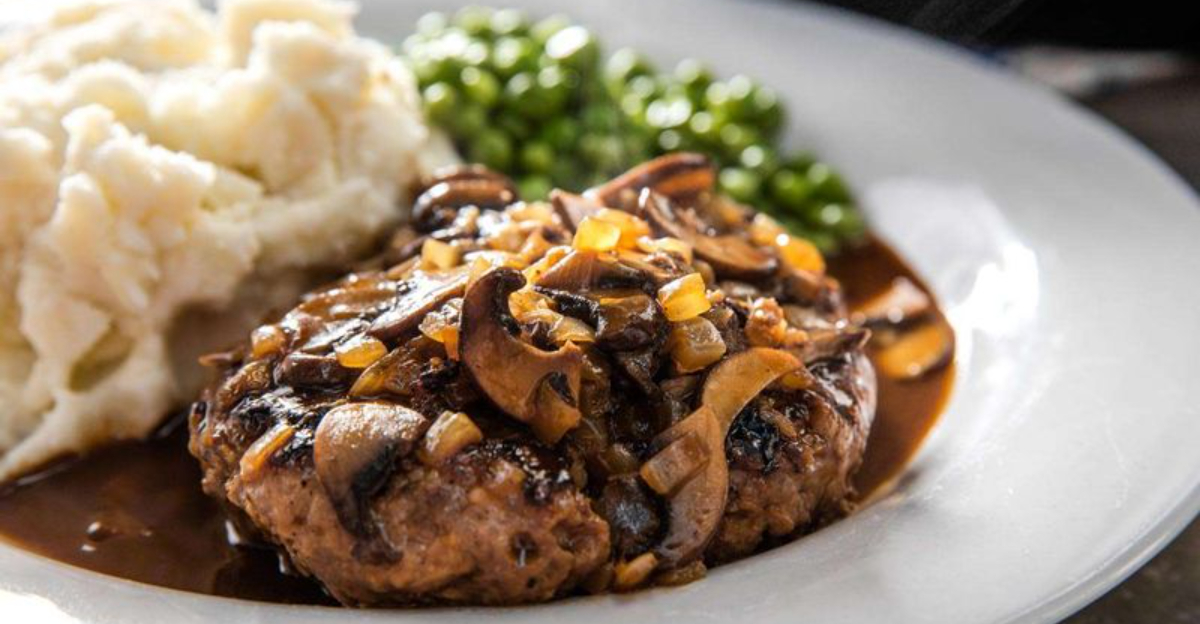13 Classic Foods That Used To Be Everywhere But Are Now Hard To Find

Remember when grandma’s kitchen smelled like dishes we rarely see today? Back in the day, certain foods graced nearly every dinner table and restaurant menu across America.
These culinary classics once defined home cooking and fancy dining alike, but have slowly disappeared from our regular rotation.
Let’s take a trip down memory lane to rediscover these forgotten food treasures that have become culinary endangered species.
1. Aspic: The Wobbly Meat Jello That Vanished
Savory meat-infused gelatin molds once crowned dinner party tables everywhere! Those shimmering, jiggly masterpieces showcased vegetables, meats, and seafood suspended in crystal-clear broth jelly.
Housewives competed for aspic supremacy at neighborhood gatherings, with recipes passed down through generations.
The art of proper aspic-making required patience, precision, and plenty of refrigerator space.
Today, you’d be hard-pressed to find this retro showstopper outside vintage cookbooks or ultra-traditional European restaurants. Most modern diners simply can’t stomach the idea of cold meat jello.
2. Beef Wellington: The Luxurious Showstopper
Wrapped in golden pastry and hiding a perfect medium-rare tenderloin, Beef Wellington once symbolized the pinnacle of sophisticated entertaining.
The laborious process—layering beef with mushroom duxelles, sometimes foie gras, and encasing it all in delicate puff pastry—made it a true special occasion dish.
Famous chefs like Julia Child championed this British creation in mid-century America. Its popularity soared during the 1960s and 70s when elaborate dinner parties were social currency.
Finding this masterpiece today requires hunting down high-end restaurants or attempting the complicated recipe yourself.
3. Ambrosia Salad: The Marshmallow Cloud Dessert
Fluffy, sweet, and impossibly colorful—ambrosia salad was the highlight of potlucks everywhere!
This heavenly concoction of mini marshmallows, coconut flakes, canned fruit, and whipped cream brightened countless holiday tables.
Grandmas nationwide had their own special versions, some adding sour cream, others insisting on mandarin oranges or maraschino cherries.
The name itself—borrowed from Greek mythology’s “food of the gods”—hints at how beloved this simple treat once was.
While you might spot ambrosia at the occasional family reunion in the South, this once-ubiquitous dessert has largely disappeared from American tables.
4. Liver and Onions: The Polarizing Protein
Sizzling in butter alongside caramelized onions, liver was once a staple on dinner tables and diner menus nationwide.
Budget-conscious families appreciated this affordable protein packed with iron and vitamins, while diners served it as a blue-plate special.
Generations grew up eating this distinctive dish, though children often needed coaxing to clean their plates.
The rich, mineral flavor paired with sweet onions created devoted fans and passionate haters in equal measure.
Today’s supermarkets still stock liver, but few home cooks know how to prepare it properly, and even fewer restaurants dare to feature it prominently.
5. Jell-O Mold Desserts: The Technicolor Party Centerpieces
Nothing screamed “special occasion” in mid-century America quite like a towering, multi-layered Jell-O mold!
These wobbly wonders came in psychedelic colors, often featuring suspended fruit, marshmallows, or even cream cheese.
Homemakers invested in specialized copper molds shaped like bundt cakes, fish, or elaborate flowers.
Kraft published entire cookbooks dedicated to the art of Jell-O architecture, promoting flavors we’ve long forgotten like celery, mixed vegetable, and seasoned tomato.
While basic Jell-O cups survive in cafeterias and hospitals, the elaborate molded masterpieces that once crowned holiday buffets have virtually disappeared.
6. Salisbury Steak: The TV Dinner Champion
Before fast food dominated quick meals, Salisbury steak reigned supreme as America’s convenience food king.
This seasoned ground beef patty smothered in brown gravy became the centerpiece of the revolutionary TV dinner in the 1950s.
Named after Dr. James Salisbury, who believed ground beef could cure digestive problems, this dish found its way onto diner menus nationwide.
School cafeterias served their own unique interpretations to generations of hungry students.
While frozen versions still lurk in supermarket freezers, homemade Salisbury steak has largely vanished from family dinner rotations and restaurant offerings.
7. Chicken à la King: The Creamy Hotel Classic
Luxurious yet comforting, Chicken à la King once graced menus from fancy hotels to home kitchens.
This elegant dish featured tender chicken chunks swimming in a velvety sauce with mushrooms, peppers, and sometimes peas or pimientos.
Legends claim it was created for wealthy hotel patron E. Clark King II in the 1890s, though several chefs dispute its origin.
Regardless, by mid-century, it had become the go-to dish for ladies’ luncheons and elegant dinner parties, typically served over toast points, rice, or puff pastry shells.
Today, this creamy concoction has largely disappeared except in the most traditional restaurants or nostalgic cookbooks.
8. Baked Alaska: The Magical Ice Cream Cake
Imagine the tableside spectacle: a dome of ice cream encased in meringue, set aflame to create a dessert that’s simultaneously frozen and toasted!
Baked Alaska was pure culinary magic that dazzled diners across America. Created to celebrate the Alaska Purchase in 1867, this showstopper reached peak popularity in the 1950s-60s.
Upscale restaurants would wheel it out on carts and ignite it with theatrical flair, earning gasps from delighted guests.
The complex preparation and tableside presentation requirements have made this once-common dessert nearly extinct outside of specialty restaurants and ambitious home bakers.
9. Deviled Ham: The Sandwich Spread Sensation
Wrapped in its distinctive white paper with a red devil logo, Underwood’s Deviled Ham was once a pantry staple nationwide.
This spicy, spreadable ham paste transformed ordinary sandwiches into quick, flavorful meals for generations of Americans.
Busy moms relied on it for school lunches, while hosts whipped it into dips for cocktail parties.
The convenience factor—shelf-stable and ready to spread—made it wildly popular during the mid-20th century when convenience foods boomed.
Though still manufactured today, this once-ubiquitous spread has faded from most grocery shelves and recipe collections, replaced by more modern sandwich fillings.
10. Waldorf Salad: The Ritzy Hotel Creation
Born at Manhattan’s prestigious Waldorf-Astoria Hotel in the 1890s, this crunchy apple-walnut masterpiece quickly became America’s society salad.
The original simple mix of apples, celery, and mayonnaise (walnuts came later) offered a refreshing contrast to heavy Victorian meals.
By the mid-20th century, Waldorf Salad had democratized, appearing in community cookbooks and Sunday dinner tables nationwide.
Families added their own twists—grapes, raisins, or even marshmallows—while maintaining the signature mayo dressing.
Today, you’ll rarely spot this once-famous salad outside of traditional steakhouses or nostalgic cookbook collections.
11. Creamed Chipped Beef on Toast: The Military Mainstay
Affectionately (or not-so-affectionately) nicknamed “SOS” by military personnel, this humble dish of dried beef in white sauce poured over toast fed countless American soldiers during World Wars I and II.
Veterans brought their taste for it home, making it a common breakfast in mid-century households. Budget-conscious families embraced this protein-packed meal during tough economic times.
The Stouffer’s frozen food company even built part of their early success on a commercial version.
While still remembered fondly by many Baby Boomers, this once-ubiquitous dish has largely retreated to diners in military towns and nostalgic cookbooks.
12. Tuna Noodle Casserole: The Budget-Friendly Bake
Nothing epitomized mid-century American home cooking quite like the humble tuna noodle casserole!
This budget-stretching dish combined canned tuna, egg noodles, and cream of mushroom soup, topped with crushed potato chips or breadcrumbs.
Church cookbooks across America featured countless variations, some adding peas, cheese, or pimientos. The dish became so common during the 1950s-70s that it was served weekly in millions of households.
While still occasionally made by nostalgic cooks, this once-weekly dinner standard has largely disappeared from regular meal rotations and potluck tables.
13. Veal Parmesan: The Italian-American Restaurant Standard
Tender breaded veal cutlets smothered in tomato sauce and melted cheese once headlined Italian-American restaurant menus nationwide.
This indulgent dish represented the pinnacle of special occasion dining for generations of families celebrating birthdays and anniversaries.
Popularized in the post-WWII era when Italian cuisine was becoming mainstream in America, veal parm (as it was affectionately known) was the signature dish that chefs used to showcase their culinary prowess.
Home cooks attempted to recreate the magic for Sunday dinners. Changing attitudes about veal production and rising costs have pushed this once-standard dish into relative obscurity.
